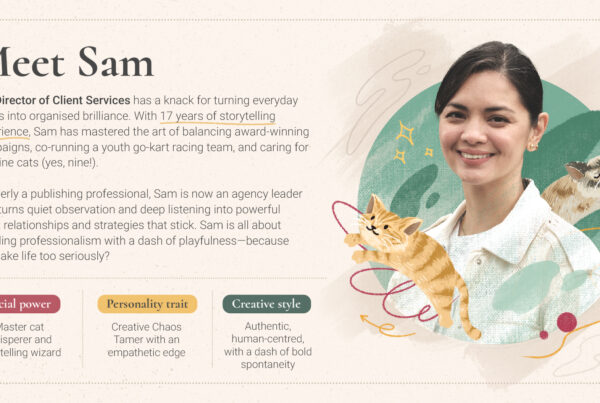
Marketers today face a data deluge.
While data analytics tools are supposed to give us clarity on customer journeys and marketing decisions, they’ve instead left us short-sighted.
We tweak campaigns based on short-term metrics and forget to correlate long-term performance with growth. We expect quality leads after sending a few emails for a product that takes a year to sell.
Today’s economic situation has exacerbated our impatience, as business budgets force us to chase results that show up next month, not next year.
And that’s justifiable—the business needs to survive, after all. Without short-term success, there’s no chance for long-term growth, unless you’ve got immensely deep pockets or a product governments clamor to fund.
But eventually, ‘next year’ becomes today. The buyers that weren’t in-market last year are now actively searching for a solution. And you can bet they’ll start with the brands they already know, as 90% of B2B buyers do.
If you’ve invested in aspirational content, you may be one of the brands at the top of their minds.
The role of aspirational content in your strategy
Aspirational content is content that sells you a vision of your future self.
Its power lies in showing customers a different way to think about their problems—thereby redirecting demand from an adjacent category to yours.
While tactical content shows you how to do something and strategic content helps you think about something in a different way, aspirational content shows how your reality can change if you do something else.

It’s Red Bull and GoPro using extreme adventure videos to sell drinks and cameras. It’s hotels and airlines publishing travel magazines to influence travelers’ next choice of destination.
This works in B2B too:
- Think of Xero telling SME owners they can actually enjoy growing their business with the use of beautiful, cloud-based accounting software,
- Or GrabGifts talking about how much more meaningful, enjoyable, and practical employee and customer rewards would be if they were personalized,
- Or a logistics company telling online merchants they can control the customer experience by building their own sites (and choosing their own delivery partners) instead of defaulting to e-commerce platforms.
By addressing potential customers’ deep desires and telling the stories of others who have achieved the same dreams, these brands sear their names into customers’ memory.
This is crucial because at any given time, roughly 95% of your potential customers are not yet actively searching for a product or solution. That’s when you want them to learn of your brand—not when they’re already in-market, at the tail end of their buyer journey, having already formed brand preferences.
These out-of-market customers may not even be “within” your funnel yet. They might be looking for solutions in an adjacent category, not realizing you could solve their core problem too — until they encounter your aspirational content.
What aspirational content is (and isn’t)
Say an SME financing company produces a travel series featuring a Singaporean leather artisan who has become globally known. The artisan is traveling the world, visiting tanneries, learning from fellow craftspeople, and launching an apprenticeship program.
A local jewelry designer who’s been trying to grow their business sees the video. As a result, the jeweler now dares to believe they can make their mark beyond Singapore, too.

Instead of being content to just figure out what local social media groups to advertise in (tactics) or whether or not to position their brand for a larger demographic (strategies), the jeweler is driven to transcend their current reality (aspiration). They might reach out to the video producer or to the artisan, and later on, realize that they can seek SME financing to expand regionally.
This hypothetical scenario shows what aspirational content is. It’s content that:
- connects with the audience on an emotional level,
- solves the personal level of customer pain,
- depicts a new reality where that pain has been solved,
- sets a person on a new customer journey,
- and continues to inspire them to stay on track in their new journey.

Aspirational content is not just awareness content or customer stories
We think this type of content deserves its own name because awareness-stage content in B2B typically focuses on practical advice.
Nothing wrong with that—helpful content gets you on a potential customer’s radar and makes you a reliable resource.
But such content rarely addresses the personal level of customer pain (more on this later).
And when B2B marketers do tell stories, we tend to package them as case studies. These case studies typically dwell on processes and product solutions. They gloss over the beautiful new reality the customer is now enjoying.
Aspirational content is not about “creating demand”
Rather, it’s about addressing the motivations and fears that drive consumer behavior, even if those customers are currently looking for solutions in a product category that’s different from yours.
In our earlier example, the jeweler might be researching how to create shoppable Instagram posts or build a brand through Tiktok.
Instead of simply addressing this behavior at face value, our role as marketers is to ask, “Why do you want to create shoppable Instagram posts? What do you want to achieve by building your brand on Tiktok?”
The answer—be it to grow their business enough to sustain one’s family, to make a mark on the Asian design scene, or to make ethical, synthetic diamonds fashionable—tells us the customer isn’t simply looking for social media marketing solutions. They’re looking for any solution that would help them achieve their aspirations.
And that means your competitors aren’t just other brands within your category. They’re any company that’s trying to solve the same customer problem you’re solving.
Aspirational content is not a pure SEO play
It’s a branding exercise.
If you, a marketer for the SME financing company, create content only around keywords like “financing for small business” or “SME financing for business expansion” or even “how to expand your business across Southeast Asia” because that’s what leads people to your site and that’s what your competitors rank for, you’re missing out on capturing the business owners who could use financing to fund their growth but haven’t considered it an option yet.
Instead of optimizing for a narrow set of keywords based on your product, target keywords based on the customer problem. This requires understanding the customer on practical, intellectual, and emotional levels.
You also have to cast a wide net by distributing and remixing your content across multiple channels beyond search.
Aspirational content is not the type of content that shows up in a last-touch attribution model
Rather, aspirational content lets you capture emerging opportunities from new audience segments or markets very early in their customer journey, as well as future opportunities to disrupt a market.
It aligns with the classic Three Horizons model for business growth and sustainability by McKinsey:
- Horizon 1 ideas provide continuous innovation to a company’s existing business model and core capabilities.
- Horizon 2 ideas extend a company’s existing business/model and core capabilities to new customers, markets or targets.
- Horizon 3 is the creation of new capabilities to take advantage of or respond to disruptive opportunities or to counter disruption.
From The Alchemy of Growth: Practical Insights for Building the Enduring Enterprise
Just as companies must devote resources to Horizon 1 without neglecting Horizons 2 and 3, you need to allot some of your marketing resources towards capturing emerging opportunities.
How to include aspirational content in your content strategy
1. Discover pain points on a personal level, not just professional
Classic sales strategy categorizes pain points based on their level of significance and urgency:
- Issues. Surface issues are problems that both customers and marketers can identify easily because they tend to occur frequently. They may either be symptoms of a systemic problem, or the cause of it.
- Impact. Negative business impact, risks and threats are a regular part of a business’ lifecycle. They often arise from a snowballing of surface issues. As these problems lie beneath the surface of day-to-day work, they feel important, but not always urgent.
- Implications. Adverse personal implications seldom happen, though you might often anticipate their occurrence. When such problems occur, they feel like catastrophes and you want to resolve them instantly—because otherwise, they’ll threaten your status quo and cause you to lose something precious.
Let’s take a different example.
Say an eCommerce platform wants to convince traditional brick-and-mortar retailers to take their business online. Their target customers’ pain points might look like this:
- Surface issue: I have fewer walk-in customers now than I did last year.
- Negative business impact: My business might not last till the end of the year.
- Adverse personal implication: Now I don’t have anything to pass on to my children when they grow up.
The first level of pain is easier to identify because it’s manifested in the day-to-day. The retail store owner probably complains a lot about it. You could also infer it from observing dwindling foot traffic.
While negative business impact isn’t immediately obvious to an outsider, you can unearth it by interviewing retail owners or reading news about business trends in the area. The hard data—the balance in the business’ bank account—makes the customer aware of the business threat too.
But not having a legacy to pass on to one’s children—that’s a difficult thing to talk about. Mere observation and casual chats won’t tell you about your potential customer’s deepest pain. You need to dig for tons of qualitative data to find this out.
The implication in our example may sound dramatic, but it’s grounded in fact.
In 2021, Xero conducted a study to discover behavioral barriers to technical adoption among small businesses. They found that 6 in 10 of their Singaporean respondents started a small business for family reasons.

In their ensuing report, Xero asked: “For [those who delay], might a focus on familial legacy and sustainability of business help tip the scales towards greater technology adoption?”
Xero discovered this personal pain point only because they took a behavioral science approach to what would otherwise have been a run-of-the-mill survey. Their methodology involved measuring not just behavioral patterns and barriers, but also deeply held beliefs and perceptions about technology adoption.
2. Craft content for emotional connection, not only tactical or strategic impact
Surface-level problems can be solved with processes and tools.
The brick-and-mortar retailer might research about “how to make my storefront more attractive to passersby” or “how to maximize profits”.
Their search will lead them to tactical content on other companies’ blogs, not yours.
Meanwhile, negative business impact requires a strategic and systemic solution.
The shop owner might wonder: “Should I redesign my store to offer an immersive shopping experience?” Or: “Can I increase my profit margins if I switch to a consignment basis or renegotiate my contracts with suppliers?”
They will find answers in strategic (thought leadership) content. Again, probably not yours.

These questions reflect the confines of the brick-and-mortar retailer’s vision.
Your job as an aspirational content marketer is to move the potential customer enough for them to imagine a new reality, convince them it’s in their best interest to make a change, and drive them to act.

Here’s what aspirational content might look like for an eCommerce platform that wants to nudge brick-and-mortar retailers to take their business online:
- A photo essay series a la Humans of New York featuring second-generation business owners who’ve transitioned from offline to online
- Interview features of entrepreneurs talking about the most significant technological adoption they’ve made for their business
- A publication called Legacies, celebrating business owners who have sustained and prepared their business for the next generation
- A day-in-the-life vlog of a traditional retailer who has shifted to eCommerce
- A newsletter on failed businesses where founders share how resistance to change contributed to their business closure.
Some of you might protest. It sounds too (gasp) lifestyle. B2B marketing is serious, logical business!
Or is it? For all the talk of customer personas over the past decade, much of B2B content marketing still sounds like we’re talking to organizations, not individuals.
We forget that businesses are made up of people. When something goes wrong, a person gets blamed. When a breakthrough happens, a person is rewarded.
People, not disembodied entities, make decisions. Repeated studies by Daniel Kahneman, a Nobel Prize-winning psychologist and economist, have shown that humans make decisions largely on emotions and cognitive biases, even when we believe we’re being logical.
However, most B2B business leaders (98%) think B2B brands fail to connect with their audiences on both rational and emotional levels, according to a UK study. Meanwhile, C-suites—especially CFOs and COOs—stated they respect brands that aren’t scared to have an opinion, even if it’s a disruptive one.
That means you have an opportunity to wield a powerful B2B content marketing strategy before your peers catch on. And if you’re still looking for a reason to invest in emotional connection, consider it a way to stand out in a sea of AI-generated copycat content.
3. Measure for long-term performance
You can justify an article about tools and processes by showing how you’ve highlighted your product’s features and boosted keyword ranking.
You can show the impact of opinionated content by reporting social engagement and conversations your thought leadership article has generated.
But aspirational content is a long game.
Like a specialty shop, it needs to be interesting and memorable enough to gain a potential customer’s attention. People need to encounter it regularly until eventually, they visit.
In this scenario, ROI takes time. Many potential customers who encounter your aspirational content are far from the decision stage of their buyer’s journey.
All this is to say that aspirational content is crucial to building a strong, well-known brand. Brand-building efforts pay off even in B2B: research shows that 80-90% of B2B buyers already have vendors in mind even before they start researching for one. Plus, 90% of them will end up buying from one of those vendors they’d pre-identified. This puts B2B companies with strong, memorable brands at an advantage.
WARC editor Ann Marie Kerwin puts it elegantly: “What is sometimes lost in the deliberations over percentages and channels is the advantage built in for marketers who have consistently put time and effort into brand-building. The strongest brands tap into an emotional core; our collective hopes, individual aspirations, or the feeling of shared experiences.”
It all started with aspiration—now is the time to revisit this approach
At this point you might be wondering: doesn’t aspirational content feel a bit manipulative? It’s like we’re exploiting the customer’s deepest hopes and fears.
Truth is, there’s no simplistic answer to this age-old dilemma—be it in politics, education or marketing. Anything that involves influence and persuasion can’t be black-and-white.
As content marketers, our best bet is to focus on empowering customers to achieve their dreams and prevent their fears from happening.
We can keep our content marketing strategy focused on connecting pain points with solutions, and make sure our audiences walk away from a piece of content having learned something new that can make their lives better—or even different.
—
200+ industry-leading tech companies in Southeast Asia are happy clients of With Content. Join them and start delivering valuable content to your potential customers today.



